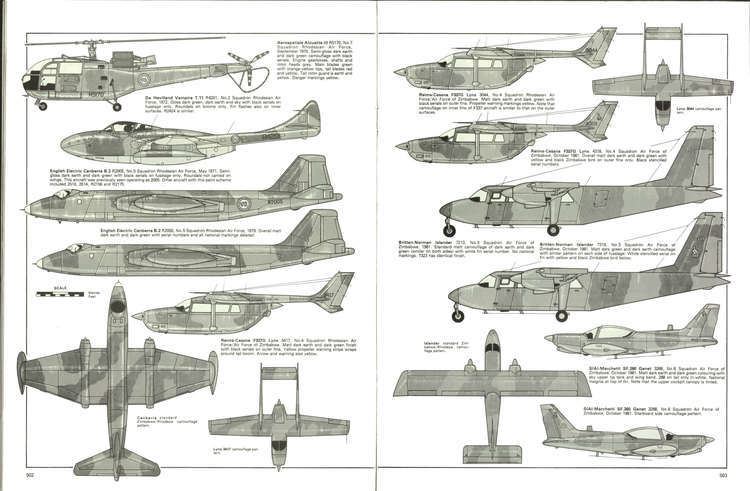Disbanded 1980 | Founded 1964 | |
Service branches Rhodesian Army Rhodesian Air ForceBritish South Africa PoliceMinistry of Internal Affairs Guard Force Similar Selous Scouts, Rhodesian Air Force, British South Africa Pol, Zimbabwe People's Revolutio, South African Defence | ||
Rhodesian security forces
The Rhodesian Security Forces were the military forces of the Rhodesian government. The Rhodesian Security Forces consisted of a ground force (the Rhodesian Army), the Rhodesian Air Force, the British South Africa Police and various personnel affiliated to the Rhodesian Ministry of Internal Affairs (INTAF). Despite the impact of economic and diplomatic sanctions, Rhodesia was able to develop and maintain a potent and professional military capability; in June 1977, Time magazine reported that "man for man, the Rhodesian army ranks among the world's finest fighting units."
Contents
- Rhodesian security forces
- Rhodesian Army
- Rhodesian Air Force
- British South Africa Police
- INTAF
- Guard Force
- Combined Operations
- Senior military officials in Rhodesia
- References

The Rhodesian Security Forces of 1964–80 traced their history back to the British South Africa Company armed forces, originally created during company rule in the 1880s and 1890s. These became the armed forces of the British self-governing colony of Southern Rhodesia on its formation in 1923, then part of the Federation of Rhodesia and Nyasaland military in 1953. After the break-up of the Federation at the end of 1963, the security forces assumed the form they would keep until 1980.

As the armed forces of Rhodesia (as Southern Rhodesia called itself from 1964), the Rhodesian Security Forces remained loyal to the Salisbury government after it unilaterally declared independence from Britain on 11 November 1965. Britain and the United Nations refused to recognise this, and regarded the breakaway state as a rebellious British colony throughout its existence.

The security forces fought on behalf of the unrecognised government against the Zimbabwe African National Liberation Army (ZANLA) and the Zimbabwe People's Revolutionary Army (ZIPRA)—the military wings of the Marxist–Leninist black nationalist Zimbabwe African National Union (ZANU) and Zimbabwe African People's Union respectively—during the Rhodesian Bush War of the 1960s and 1970s.

The Lancaster House Agreement and the return of Rhodesia to de facto British control on 12 December 1979 changed the security forces' role altogether; during the five-month interim period, they helped the British governor and Commonwealth Monitoring Force to keep order in Rhodesia while the 1980 general election was organised and held. After the internationally recognised independence of Zimbabwe in April 1980, the Rhodesian security forces, ZANLA and ZIPRA were integrated to form the new Zimbabwe Defence Forces.
Rhodesian Army
The majority of the Southern Rhodesia Volunteers were disbanded in 1920 for reasons of cost, the last companies being disbanded in 1926. The Defence Act of 1927 created a Permanent Force (the Rhodesian Staff Corps) and a Territorial Force as well as national compulsory military training. With the Southern Rhodesia Volunteers disbanded in 1927, the Rhodesia Regiment was reformed in the same year as part of the nation's Territorial Force. The 1st Battalion was formed in Salisbury with a detached "B" company in Umtali and the 2nd Battalion in Bulawayo with a detached "B" Company in Gwelo. Between the World Wars, the Permanent Staff Corps of the Rhodesian Army consisted of only 47 men. The British South Africa Police (BSAP) were trained as both policemen and soldiers until 1954.
About 10,000 white Southern Rhodesians (15% of the white population) mustered into the British forces during the Second World War, serving in units such as the Long Range Desert Group, No. 237 Squadron RAF and the Special Air Service (SAS). Pro rata to population, this was the largest contribution of manpower by any territory in the British Empire, even outstripping that of Britain itself.
Southern Rhodesia's own units, most prominently the Rhodesian African Rifles (made up of black rank-and-filers and warrant officers, led by white officers; abbreviated RAR) fought in the war's East African Campaign and in Burma. During the war, Southern Rhodesian pilots proportionally earned the highest number of decorations and ace appellations in the Empire. This resulted in the Royal Family paying an unusual state visit to the colony at the end of the war in thanks to the efforts of the Rhodesian people.
The Southern Rhodesia Air Force (SRAF) was re-established in 1947 and two years later, Prime Minister Godfrey Huggins appointed a 32-year-old South African-born Rhodesian Spitfire pilot, Ted Jacklin, as air officer commanding tasked to build an air force in the expectation that British African territories would begin moving towards independence, and air power would be vital for land-locked Southern Rhodesia. The threadbare SRAF bought, borrowed or salvaged a collection of vintage aircraft, including six Tiger Moths, six North American Harvard trainers, an Avro Anson freighter and a handful of De Havilland Rapide transport aircraft, before purchasing a squadron of 22 Mk. 22 war surplus Supermarine Spitfire from the Royal Air Force which were then flown to Southern Rhodesia.
In April 1951, the defence force of Rhodesia was completely reorganised. The Permanent Force included the BSAP as well as the Southern Rhodesia Staff Corps charged with training and administering the Territorial Force. The SRAF consisted of a communication squadron and trained members of the Territorial Force as pilots, particularly for artillery observation. During the Malayan Emergency of the 1950s, Southern Rhodesia contributed two units to the Commonwealth's counter-insurgency campaign: the newly formed Rhodesian SAS served a two-year tour of duty in Malaya starting in March 1951, then the Rhodesian African Rifles operated for two years from April 1956.
The colony also maintained women's auxiliary services (later to provide the inspiration for the Rhodesia Women's Service), and maintained a battalion of the RAR, officered by members of the Staff Corps. The Territorial Force remained entirely white and largely reproduced the Second World War pattern. It consisted of two battalions of the Royal Rhodesia Regiment, an Armoured Car Regiment, Artillery, Engineers, Signal Corps, Medical Corps, Auxiliary Air Force and Transport Corps. In wartime the country could also draw on the Territorial Force Reserve and General Reserve. Southern Rhodesia, in other words, reverted more or less to the organisation of the Second World War.
Matters evolved greatly over twenty years. The regular army was always a relatively small force, but by 1978–79 it consisted of 10,800 regulars nominally supported by about 40,000 reservists. While the regular army consisted of a professional core drawn from the white population (and some units, such as the Rhodesian SAS and the Rhodesian Light Infantry, were all-white), by 1978–79 the majority of its complement was actually composed of black soldiers. The army reserves, in contrast, were largely white.
The Rhodesian Army HQ was in Salisbury and commanded over four infantry brigades and later an HQ Special Forces, with various training schools and supporting units. Numbers 1,2, and 3 Brigade were established in 1964 and 4 Brigade in 1978.
During the Bush War, the army included:
Rhodesian Air Force
The Rhodesian Air Force was never a large air force. In 1965, it consisted of only 1,200 regular personnel. At the peak of its strength during the Bush war, it had a maximum of 2,300 personnel of all races, but of these, only 150 were pilots actively involved in combat operations. These pilots, however, were rotated through the various squadrons partly to maintain their skills on all aircraft and partly to relieve fellow pilots flying more dangerous sorties.
British South Africa Police
The British South Africa Police (BSAP) were the first line of defence in Rhodesia, with the specific responsibility of maintaining law and order in the country.
INTAF
Rhodesian Ministry of Internal Affairs (INTAF) officers were heavily involved in implementing such civic measures as the protected villages program.
Guard Force
This was the fourth arm of the Rhodesian Security Forces. It consisted of both black and white troops whose initial role was to provide protection for villagers in the Protected Village system. During the latter stages of the Bush War they provided a role in the protection of white-owned farmland, tribal purchase lands and other strategic locations. They also raised two infantry Battalions and provided troops in every facet of the war in each of the Operational Areas. It was a vast force having over 7,200 personnel. Its headquarters were in North Avenue, Salisbury. Its training establishment was based at Chikurubi in Salisbury.
Combined Operations
The Rhodesian Bush War required that each of the security forces work in a combined effort to combat the enemy. Therefore it became essential to establish an organisation known as Combined Operations (COMOPS) in Salisbury to co-ordinate the efforts of each service. The Rhodesian army took the senior role in Combined Operations and was responsible for the conduct of all operations both inside and outside Rhodesia. COMOPS had direct command over the Joint Operational Centres (JOCs) deployed throughout the country in each of the Operational Areas. There was a JOC per Operational Area.
The operational areas were known as:
Senior military officials in Rhodesia
Source: original regiments.org (T.F. Mills) via webarchive.
